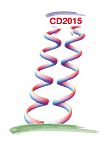Speaker
Masayasu Hasegawa
(Joint Institute for Nuclear Research, Moscow)
Description
In previous works we have shown the relation between chiral symmetry breaking, instantons, and monopoles by adding the monopoles to quenched SU(3) configurations [1,2]. We found that (i) one pair of monopoles makes one instanton. (ii) the monopole pair induces chiral symmetry breaking. This was done by measuring the chiral condensate computed from the eigenvalues and eigenvectors of the Overlap Dirac operator. In this study, we compare the low-lying (improved) eigenvalues λi of the Overlap operator with the prediction of the random matrix theory [3, 4]. First, we perform a scale-independent test using the low-lying eigenvalues as in Ref. [5]. Our results are consistent with their results and the prediction of the random matrix theory (RMT). Next, we add one pair of monopoles with charges mc varying from zero to four, to the SU(3) quenched configurations, and compare the low-lying eigenvalues with the prediction of the random matrix theory. We find that the results of the scale-independent tests are consistent with the prediction of the random matrix theory as shown in Fig. 1 (λj < λk, 1 ≤ j, k ≤ 4, j ̸= k). Therefore, the added pair of monopoles does not affect the spectra of the Overlap Dirac operator. Moreover, we show that the spectral density ρ(λ) increases with the monopole charges mc as shown in Fig. 2. These results indicate that the monopoles are related to the chiral symmetry breaking. We are presently calculating the chiral condensate, and the Banks-Casher relation. In this talk, we would like to present preliminary results showing the relation between the chiral symmetry breaking and monopoles.
References
[1] Adriano Di Giacomo, and Masayasu Hasegawa, arXiv: 1412.2704.
[2] Adriano Di Giacomo, and Masayasu Hasegawa, Phys. Rev. D 91 (2015) 054512.
[3] S. M. Nishigaki, P. H. Damgaard, and T. Wettig, Phys. Rev. D 58 (1998) 087704.
[4] P. H. Damgaard, and S. M. Nishigaki, hep-th/0006111 (Phys. Rev. D 63 (2001) 045012).
[5] L. Giusti, M. L¨uscher, P. Weisz, and H. Wittig, J. High Energy Phys. 11 (2003) 023.
Primary author
Masayasu Hasegawa
(Joint Institute for Nuclear Research, Moscow)
Co-authors
Prof.
Adriano Di Giacomo
(University of Pisa, Department of Physics and INFN)
Dr
Fabrizio Pucci
(Service 3BIO, Universite Libre de Bruxelles)

